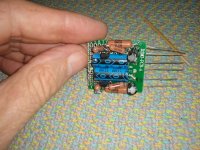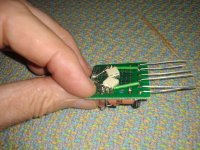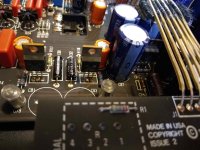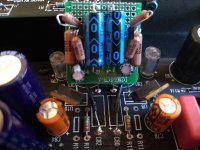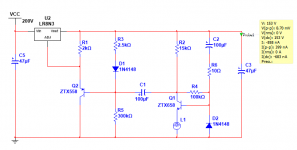D-noizator
I built a +- D-noizator to install in my phono preamp. The PS for the preamp part(16db gain stage, volume control) is two sets of 317/337 regulators. The MM/MC sections have additional regulator sections. I added the D-noizator to the second set of regulators. The change in sound was two part. The plus was an increase in both frequency extremes, pushing out more presents, while adding definition. The mids seemed smoother and warmer. The negative effect was the soundstage became less defined, almost blurry. I suspected oscillating. I checked the output with no signal, clean as my 10 mhz scope could show(?). I couldn't find any oscillating signal in the PS. Liked all the other attributes, but removed it to recoup the soundstage. Any ideas?
I built a +- D-noizator to install in my phono preamp. The PS for the preamp part(16db gain stage, volume control) is two sets of 317/337 regulators. The MM/MC sections have additional regulator sections. I added the D-noizator to the second set of regulators. The change in sound was two part. The plus was an increase in both frequency extremes, pushing out more presents, while adding definition. The mids seemed smoother and warmer. The negative effect was the soundstage became less defined, almost blurry. I suspected oscillating. I checked the output with no signal, clean as my 10 mhz scope could show(?). I couldn't find any oscillating signal in the PS. Liked all the other attributes, but removed it to recoup the soundstage. Any ideas?
Attachments
Any ideas?
One explanation could be that changed soundstage perception is result of phase change in harmonics. Unmodified voltage regulators, for sure, had some shortcomings as it would be unlikely to experience big overall change introducing very good regulators (denoisers).
In the Pass labs forum section it was extensively discussed how second harmonic phase affect listeners perception of the sound stage depth and this was explained my Nelson Pass as well. For instance, negative second harmonic phase (relative to the signal phase) is perceived as more depth, with recessed instruments position while positive phase as more “in face”.
One recommended way of testing effect is to change polarity at speakers terminals. It is true that both signal and harmonics change polarity, but perception is different. You could try that to see if there is any change. Probably there will not be any but it is worth to try considering that you need only 1 minute to change speaker connector positions.
Don’t anyone accuse me of peddling snake oil theories as credible people vouch for this.
I built a +- D-noizator to install in my phono preamp. The PS for the preamp part(16db gain stage, volume control) is two sets of 317/337 regulators. The MM/MC sections have additional regulator sections. I added the D-noizator to the second set of regulators. The change in sound was two part. The plus was an increase in both frequency extremes, pushing out more presents, while adding definition. The mids seemed smoother and warmer. The negative effect was the soundstage became less defined, almost blurry. I suspected oscillating. I checked the output with no signal, clean as my 10 mhz scope could show(?). I couldn't find any oscillating signal in the PS. Liked all the other attributes, but removed it to recoup the soundstage. Any ideas?
It seems we were implementing a similar way for the D-noizator and the Dienoiser, using prototype pcbs for them. I used DipTrace to place the parts and join the connections.
Only one side of the pcb was used for the solder side on both versions. It ended up quite small and clean.
I didn't get any comments about them.
I haven't giving up, the positive attributes are encouraging. I did expect and experience a smoother presentation. Especially the mids( expected for a cleaner PS). The localization in the center of the soundstage just stopped. I think I understand losing a bit of noise may smooth out the tone. However the center image of my go two test CDs(meridian)and albums(vpi/dynavector) vanished. The extreme soundstage effects where still present, but say the middle half was blurry. The leads of the d-noizator are either in the same vias or soldered to the regulator' legs, quite short. I understand the point of going from edgy to smooth presentation, giving a "dull or boring" effect. Been there, done that. This isn't like a edgy to butter change. Without the d-noizator is still quite nice. There is a tonal improvement with it installed. Speaker phasing? Possibly, but I have experimented before this episode and didn't perceive a noticable change?
As Elvee pointed out, with denoiser LM regulator behaves more like an ideal voltage source, with greatly reduced output impedance and noise.
I would first try to rule out does regulator’s lower output impedance somehow affect the circuit it supplies. Add small value resistor (ie. 0.1 Ω or even greater) in the supply lines. If that changes perceived sound stage even a bit, then it is the right trail.
How big is the capacitor at regulator output? If it is like 1000 µF or more, it could be worth to check how it works with 100 to 220 µF.
I would first try to rule out does regulator’s lower output impedance somehow affect the circuit it supplies. Add small value resistor (ie. 0.1 Ω or even greater) in the supply lines. If that changes perceived sound stage even a bit, then it is the right trail.
How big is the capacitor at regulator output? If it is like 1000 µF or more, it could be worth to check how it works with 100 to 220 µF.
Reinstalled the denoizator. Listened for several hours, CD, albums, back to CD. The bass is almost overwhelming. I stuff the ports to mitigate without relocating the speakers at this point. Yes that much change. The top end is more refined, mid treble seems muted. This may be attributed to dominating mids and bass(my system?), and or a refined PS. Great PSs remove the grunge in and around the music. The voices are smooth and nice. But just like before, overall the sound seems rounded and has lost clarity/precise location. Toed in the speakers, helped somewhat. Dull and boring?? Maybe just my taste. There is luring characteristics to the sound. Don't we wish we could pick and choose. The beauty of the device is there is an easy path to restoring the previous circuit. Anyone else tried this mod?
Sent from Yahoo mail
Sent from Yahoo mail
Attachments
I'm accepting Elvee's idea here;
" but about upgrading existing equipments using 317/337's, which certainly number in the millions, if not more.
All you have to do is lift the cover, stick a post-stamp-sized PCB somewhere using a double-sided adhesive or a dab of silicone, solder 3 connections and you are done. The worst you might have to do is to lift one side of a capacitor."
Simplistic, small and good deal of improvement in parameters. It does that. Wondering if others have experienced a change in their equipment similar or different to mine? Just my experience/equipment or taste in sound? Certainly there are better regulators. But this was an easy simple trial and reversible. I take out about 25% of my mods, and learned that the hard way making non reversible changes.
" but about upgrading existing equipments using 317/337's, which certainly number in the millions, if not more.
All you have to do is lift the cover, stick a post-stamp-sized PCB somewhere using a double-sided adhesive or a dab of silicone, solder 3 connections and you are done. The worst you might have to do is to lift one side of a capacitor."
Simplistic, small and good deal of improvement in parameters. It does that. Wondering if others have experienced a change in their equipment similar or different to mine? Just my experience/equipment or taste in sound? Certainly there are better regulators. But this was an easy simple trial and reversible. I take out about 25% of my mods, and learned that the hard way making non reversible changes.
Last edited:
HV D-Noizator
I have a bunch of the LR8N3 HV regulators -- will only dissipate 0.75W (the TO-252 package will do 2.5W). Very handy as a high voltage current source, but no champ when it comes to noise.
This regulates, but I have yet to test it for noise, PSRR and Z-out. The first version I built oscillated at 61MHz! There is only a faint trace of oscillation in this version:
I have a bunch of the LR8N3 HV regulators -- will only dissipate 0.75W (the TO-252 package will do 2.5W). Very handy as a high voltage current source, but no champ when it comes to noise.
This regulates, but I have yet to test it for noise, PSRR and Z-out. The first version I built oscillated at 61MHz! There is only a faint trace of oscillation in this version:
Attachments
Interesting. I had built two of the d-noizators, so installed both on the first overall regulator 317/337 set and the post 317/337 set and tested it. The sound coming from my device was so poor I again removed them. I double rechecked the wiring, seems correct. I stymied. Other experiences?
A more objective assessment would be to verify with measuring instruments to quantify the possible improvements that this accessory brings to the existing circuit. If improvements cannot be verified and quantified, it will be difficult to accept that what is perceived is due only to the attached d-noizators. It would be necessary to see what the 0 V return circuit is like in the schematic intervened, since this is very important and influential.
Best regards
Best regards
Interesting. I had built two of the d-noizators, so installed both on the first overall regulator 317/337 set and the post 317/337 set and tested it. The sound coming from my device was so poor I again removed them. I double rechecked the wiring, seems correct. I stymied. Other experiences?
What we found (after the Linear Audio article had been written) -- the error amplifier in conventional regulators can impart harmonics onto the supply rail which are not defeated. The listening test used Erno Borbely's All JFET line amplifier with only 40dB of PSRR so it was apparent which devices were smearing the sound. The LM317/337 used all by themselves were no match for the Jung or Sjostrom regulators.
I haven't done this with Elvee's elegant design, but you could. The design really excels at noise, psrr and output impedance.
When Jackinnj pointed out very high freq oscillation experience, I started thinking my 10mhz scope may have missed something. Didn't see any problem oscillations. I re-read the thread because I remembered something about an optional resistor for stability in the lm317 denoizator. Some here built nice compact units, mine was made with through hole parts and no 33 ohm stabilizing resistor. Perhaps an example of a "Layout blunder", susceptible to oscillation. Sooo, after installing the 33 ohm resistor, I tried it out again, installing the one denoizator powering only the preamp portion. BINGO, now we are getting somewhere. It works. Just a suggestion that the resistor be included on any layout build similar to mine. Thanks LV and all for this nice enhancement!
Last edited:
When Jackinnj pointed out very high freq oscillation experience, I started thinking my 10mhz scope may have missed something. Didn't see any problem oscillations. I re-read the thread because I remembered something about an optional resistor for stability in the lm317 denoizator. Some here built nice compact units, mine was made with through hole parts and no 33 ohm stabilizing resistor. Perhaps an example of a "Layout blunder", susceptible to oscillation. Sooo, after installing the 33 ohm resistor, I tried it out again, installing the one denoizator powering only the preamp portion. BINGO, now we are getting somewhere. It works. Just a suggestion that the resistor be included on any layout build similar to mine. Thanks LV and all for this nice enhancement!
Are you using LV's denoisers or Diego's dienoisers (i.e. with Sziklai pair)? IME and based on Spice simulations denoiser should be stable even without the compensation resistor. Dienoiser however is only conditionally stable so adding it to any 317/337 based power supply without careful study is asking for trouble. But adding the compensation resistor should make dienoiser more stable.
I'm using LV's denoiser circuit. The device PS I'm modifying has a 317/337 regulator for the entire device. This in turn splits into separate supplies for a MM, MC, circuits each with separate channel emitter followerer supplies, and also feeds another 317/337 set for only the preamp circuit. I first added a denoiser to the preamp 317/337 set. Some aspects of the sound improved, some not. I next added a denoiser to the overall 317/337 set. Within 10 seconds of listening, it was obvious something was wrong. Thus I searched for a reason why this had happened. I removed the denoisers, and the original sound returned. Upon re-reading the thread coming upon post 103 and 199 where it was suggested that a 33 ohm resistor could do no harm( final circuit). I added that 33ohm resistor, and re- installed the preamp denoiser. Clearly an overall improvement across the spectrum from the original circuit. Other than using ztx transistors, my denoiser is as in post 199. Certainly made my denoiser work well. Don't have the test equipment to analyze further. I will again add a denoiser to the overall 317/337 set after listening to accustom myself to the new improved sound.
Sent from Yahoo mail
Sent from Yahoo mail
- Home
- Amplifiers
- Power Supplies
- D-Noizator: a magic active noise canceller to retrofit & upgrade any 317-based V.Reg.
